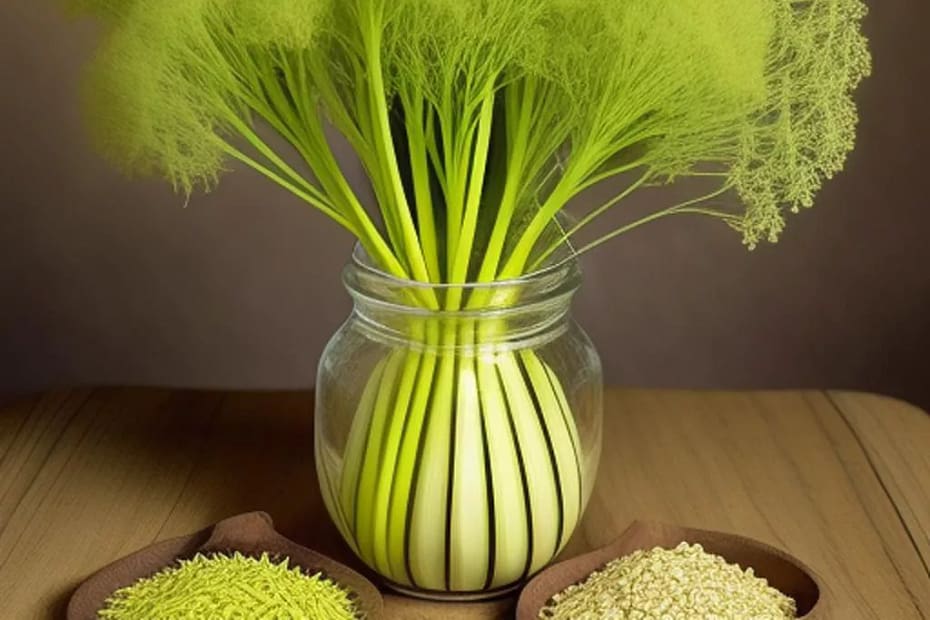Fennel (Foeniculum vulgare) is a perennial herb belonging to the Apiaceae family. It is native to the Mediterranean region but has become naturalized in many parts of the world. Fennel is widely cultivated for its aromatic seeds, which are used as a culinary spice, and its flavorful bulb and leaves, which are used as vegetables in cooking.
Appearance
Fennel plants can grow up to 2 meters (6.5 feet) in height, depending on the variety and growing conditions.The plant has a smooth, round, and hollow stem with a distinct bluish-green color. It bears feathery, pinnate leaves that are finely dissected and arranged alternately on the stem. The leaves are highly aromatic and give off a sweet, anise-like scent when crushed.
Flowers
Fennel produces umbrella-like clusters of small, yellow flowers known as umbels. These umbels are compound and can measure up to 15 cm (6 inches) in diameter. The flowers are five-petaled and arranged in a characteristic inflorescence pattern.
Seeds
After flowering, fennel produces small, elongated, and curved seeds that are approximately 4-10 mm in length.These seeds are light greenish-brown in color and have a distinct, licorice-like flavor.
Roots
Fennel has a taproot system, with a thick, fleshy root that anchors the plant into the ground.
Habitat and Cultivation
Fennel thrives in well-draining, sandy or loamy soils with good sunlight exposure. It is commonly found growing in coastal areas, along riverbanks, and on rocky slopes. The plant is also cultivated in gardens and farms for its culinary uses.
Uses
- Culinary: Fennel seeds are widely used as a spice in various cuisines, particularly in Mediterranean and Indian cooking. They add a distinct, sweet, and aromatic flavor to dishes.
- Vegetable: The bulb of Florence fennel (Foeniculum vulgare var. dulce) is harvested and used as a vegetable, often sliced thinly and added to salads or cooked in various recipes.
- Medicinal: Fennel has been used in traditional medicine for its various potential health benefits, such as aiding digestion and soothing upset stomachs.
Please note that while fennel is generally safe for culinary use and has many potential health benefits, it is essential to consult with a healthcare professional before using it for medicinal purposes, especially if you have any existing medical conditions or are pregnant.
Summarized botanical description of fennel
| Characteristic | Description |
| Scientific Name | Foeniculum vulgare |
| Family | Apiaceae |
| Type | Perennial herb |
| Height | Up to 2 meters (6.5 feet) |
| Stem | Smooth, round, hollow, bluish-green color |
| Leaves | Feathery, pinnate, aromatic, sweet scent |
| Flowers | Small, yellow, arranged in umbrella-like clusters (umbels) |
| Flowering Season | Summer |
| Seeds | Small, elongated, curved, 4-10 mm length, light greenish-brown color, licorice-like flavor |
| Habitat | Well-draining, sandy or loamy soils, coastal areas, riverbanks, rocky slopes |
| Cultivation | Commonly grown in gardens and farms |
| Culinary Use | Seeds used as a spice, bulb used as a vegetable in cooking |
| Medicinal Uses | Traditionally used to aid digestion and soothe upset stomachs |
| Caution | Consult a healthcare professional before using for medicinal purposes, especially during pregnancy or with existing medical conditions |
The information provided is based on the typical botanical characteristics and uses of fennel. Varieties and specific growing conditions may result in slight variations. Always verify information from reliable sources for accurate details.
Thank you for likes, shares and comments! 🌳🌴🌲🌵
Source OpenAI’s chatGPT Language Models, Dalle, AI trot and Fleeky
images Picsart and MIB
Invest in your future
Take time to learn
Embark on your journey in affiliate marketing and website creation alongside an incredible community and myself. Invest in your future by dedicating time to learn and earn. Take all the time you need to master the basics before aiming higher. Give it a try and sign up for free. You won't regret it! Discover the possibilities for yourself...


